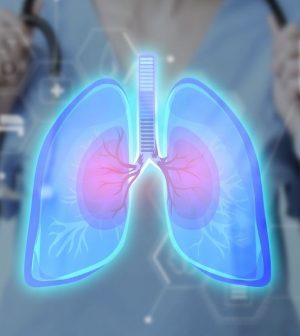- Navigating Your Midlife Crisis: Embracing New Possibilities
- City Raccoons Showing Signs of Domestication
- Mapping the Exposome: Science Broadens Focus to Environmental Disease Triggers
- One Week Less on Social Media Linked to Better Mental Health
- Your Brain Changes in Stages as You Age, Study Finds
- Some Suicide Victims Show No Typical Warning Signs, Study Finds
- ByHeart Formula Faces Lawsuits After Babies Sickened With Botulism
- Switch to Vegan Diet Could Cut Your Greenhouse Gas Emissions in Half
- Regular Bedtime Does Wonders for Blood Pressure
- Dining Alone Could Mean Worse Nutrition for Seniors
AI Guided Breath Test Could Speed COPD Diagnosis

Folks with difficulty breathing can learn if they have COPD from a new AI-guided lung test, a new study suggests.
The newly developed AI can accurately diagnose COPD using data from a single chest CT scan performed as a person inhales, researchers reported Dec. 12 in the journal Radiology: Cardiothoracic Imaging.
The AI also can tell how bad a person’s COPD has become from that scan, the researchers added.
Up to now, doctors have typically needed two CT scans to diagnose and judge COPD — one when a person has fully inhaled, and one when a person has exhaled.
“Our study shows that COPD diagnosis and staging is feasible with a single CT acquisition and relevant clinical data,” said researcher Kyle Hasenstab, an assistant professor of statistics and data science at San Diego State University.
COPD (chronic obstructive pulmonary disease) is a group of progressive lung diseases that impair a person’s ability to breathe. There’s no cure for COPD, and it’s the third leading cause of death worldwide, researchers said in background notes.
The main method of diagnosing COPD has been a spirometry test, which measures lung function through the quantity of air that can be inhaled and exhaled, researchers said.
Some hospitals now also take CT images of the lungs to aid in COPD diagnosis, because the scans can detect lung damage that could be impeding breath, Hasenstab said.
“However, this type of protocol is not clinically standard across institutions,” Hasenstab said, partly because it takes extra training for staff to be able to take good CT images and then interpret them.
Researchers hypothesized they might be able to make CT scanning for COPD available to more people if AI could interpret the scan, cutting down on the need for training.
For this study, researchers gathered inhalation and exhalation lung CT scans for nearly 8,900 patients tested between November 2007 and April 2011, along with their spirometry data.
The average age of the patients was 59, and all had a history of smoking.
The team trained the AI to predict spirometry measurements using the patients’ CT scans and clinical data.
Results showed that the AI could accurately diagnose COPD using just one of the CT scans. The AI also could reasonably say how bad the COPD had become.
When clinical data was added, the AI’s accuracy improved, researchers said.
The AI performed the same whether the CT scan was for inhalation or exhalation, researchers found.
“Reduction to a single inspiratory CT acquisition can increase accessibility to this diagnostic approach while reducing patient cost, discomfort and exposure to ionizing radiation,” Hasenstab said in a journal news release.
More information
The National Institutes of Health has more on COPD.
SOURCE: Radiological Society of North America, news release, Dec. 12, 2024
Source: HealthDay
Copyright © 2025 HealthDay. All rights reserved.










